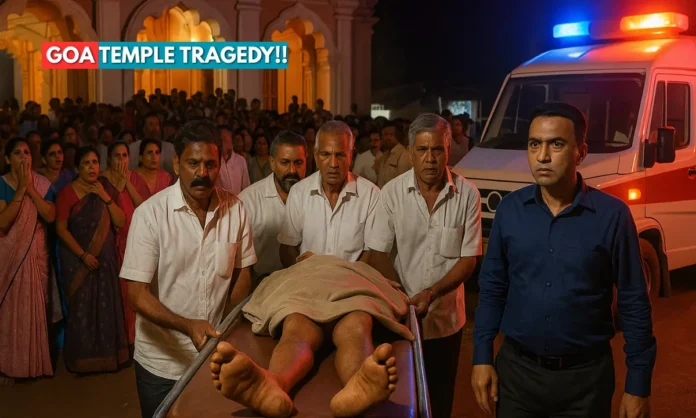SUMMARY
– Six devotees killed and dozens injured in early morning stampede at Goa’s Sree Lairai Devi Temple.
– Chief Minister Pramod Sawant promises transparent inquiry, pledges release of findings to public.
– New safety measures for religious gatherings planned across Goa following the tragedy.
Faith, Crowds, and a Fatal Turn: Goa’s Shirgao Festival Ends in Tragedy
What should have been a night of devotion ended in chaos and grief as a deadly stampede at the Sree Lairai Devi Temple in Shirgao, North Goa, claimed six lives in the early hours of May 3. Thousands had gathered for the annual temple festival, a cherished event in Goa’s cultural calendar, when the situation spiraled out of control around 3 AM. Goa Chief Minister Pramod Sawant rushed to the site, pledging a detailed and transparent investigation into the incident.
The tragedy has prompted renewed scrutiny of event safety standards at religious gatherings across India, especially in rural and semi-urban settings where emergency management infrastructure often lags. With Prime Minister Narendra Modi personally extending condolences and offering federal assistance, the spotlight is firmly on Goa’s government to act swiftly and credibly. The unfolding inquiry and resulting reforms will serve as a critical test not only for state leadership but also for the public’s faith in institutions meant to safeguard them during mass gatherings.
After Kumbh Mela, A stampede occurred during Jatra at Shirgaon temple in BJP ruled state Goa
— Sandeep Chaudhary commentary (@newsSChaudhry) May 3, 2025
In this accident 6 people died tragically and more than 15 are injured,
Chaos broke out in the massive crowd as people ran for safety. Eyewitnesses describe scenes of panic and fear,… pic.twitter.com/sOBVdQIcNN
CM Orders Swift Inquiry, Promises Transparency
- Pramod Sawant visited the site and the North Goa District Hospital within hours of the incident.
- The Chief Minister announced a full inquiry, committing to make the final report public.
- Prime Minister Narendra Modi called Sawant, offering full federal support and solidarity.
- The Goa government pledged new safety protocols for future religious festivals to prevent repeats.
Chief Minister Pramod Sawant wasted no time in responding to the tragedy. By Friday morning, he had visited both the temple site and the hospital treating the injured, announcing a probe into the stampede’s causes. Sawant’s assurance that the inquiry findings will be publicly available marks a clear shift from typical opaque investigations, signaling the administration’s understanding of the political and emotional stakes involved. The outreach from Prime Minister Modi further emphasizes the seriousness with which this incident is being treated at both state and national levels.
Public Pressure Mounts as Safety Failures Emerge
- Eyewitnesses reported inadequate crowd control measures before the stampede.
- Lack of clear emergency exits and coordination cited as major failure points.
- Opposition leaders are demanding accountability and structural reforms.
- Previous safety warnings for large festivals in Goa appear to have been ignored.
As details of the night emerge, it is becoming clear that systemic lapses contributed heavily to the scale of the tragedy. Witness accounts suggest there were insufficient barriers and emergency exits at the temple grounds, despite thousands of attendees being expected. Critics have pointed out that Goa had seen past warnings about the need for upgraded safety standards at mass events, yet reforms remained sluggish. Opposition parties have already begun calling for criminal negligence investigations against organizers and officials responsible for event clearances.
Future of Festival Safety in Goa Hangs in the Balance
- Goa plans to review and overhaul festival crowd management protocols.
- New guidelines may mandate minimum safety infrastructure for large gatherings.
- State government faces political pressure to deliver quick, visible reforms.
- Faith leaders and festival committees are also under scrutiny for event planning.
Looking ahead, the Goa government has promised sweeping changes to how religious and cultural events are organized. Proposals reportedly under discussion include mandatory safety audits, enforced crowd limits, and structured evacuation protocols for all large gatherings. Faith leaders and festival organizers are also being asked to play a more proactive role in ensuring attendee safety. The credibility of the state administration — and public trust in mass events — now rests on whether these promised reforms materialize into enforceable action rather than bureaucratic paperwork.
Goa’s Crossroads: A Moment to Act, Not Just Mourn
The tragedy at Sree Lairai Devi Temple must not fade into yet another tragic headline archived under “avoidable disasters.” Goa’s government, religious institutions, and the broader civil society face a crucial moment: transform sorrow into systemic change. Transparent investigations, real-time reforms, and an unwavering commitment to safety must define the path ahead. The lives lost deserve nothing less than a determined shift toward a future where faith gatherings celebrate life — not mourn preventable deaths.


